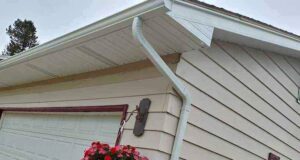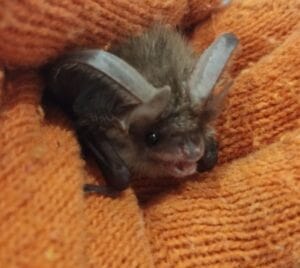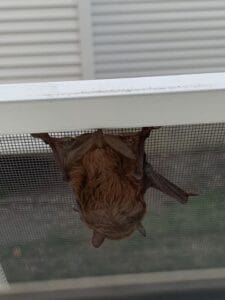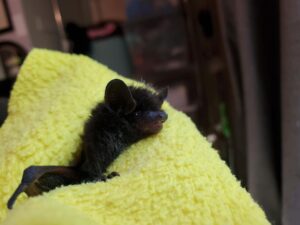Are you experiencing strange noises coming from your mobile home soffit? It could be a bat infestation. Bats are common pests that can cause damage to the structure of your mobile home and pose health risks to residents. Due to their design and construction, mobile homes provide an ideal habitat for bats. In this article Bat Removal Tips: Getting Rid of Bats in Your Mobile Home Soffit we will discuss all things you need to know about bats.

Bat Removal for Mobile Home Soffit
Ignoring a bat infestation can lead to serious consequences, including structural damage and exposure to harmful diseases like rabies. Early detection and professional removal are crucial for addressing bat infestations in mobile home soffits.
If you suspect that there are bats living in your mobile home soffit, it’s important to take action immediately.
Reasons Why Bats Enter Soffits and How to Prevent Infestations
Bats are fascinating creatures that play an important role in our ecosystem. However, when they decide to make their home in your soffit, it can quickly become a nuisance.
How do bats get in my soffit?
Bats are able to enter your home through small entry points that may be difficult to spot. Soffits are particularly attractive to bats because they provide shelter and warmth. Some common entrance points for bats include:
Cracks or gaps in the soffit boards
Holes created by woodpeckers or other animals
Open attic vents or windows
Once they have entered your soffit, bats will typically roost during the day and leave at night to feed on insects.
Why and how do I end up having bats living in my house?
There are several reasons why you may end up with bats living in your house:
Unsealed entry points: If there are any unsealed entry points into your home, such as cracks or holes in the roof or walls, bats may take advantage of these openings to gain access.
Attractive environment: Bats prefer warm and dark environments where they can roost during the day without being disturbed. Soffits provide an ideal location for them to rest undisturbed.
Nearby food sources: If there is a large population of insects near your home, such as mosquitoes or moths, this could attract bats looking for a food source.

Bat Removal Tips in Your Mobile Home Soffits
If you suspect that you have bats living in your soffit, it is important to take action immediately. Here are some steps you can take:
Identify entry points: Inspect your home for any cracks, gaps, or holes that bats may be using to gain entry. Seal these openings with caulk or other sealants.
Install bat boxes: If you want to encourage bats to roost in a more suitable location, such as a nearby bat box, make sure it is installed before sealing off the entrance points.
Use exclusion devices: These are one-way doors that allow bats to leave but prevent them from re-entering your home. They should only be used during the summer months when baby bats are old enough to fly.
Hire a professional: If you are unsure of how to handle a bat infestation, it is best to hire a professional pest control company that specializes in bat removal.
Preventing infestations
Preventing bat infestations starts with sealing all possible entrance doors and attic openings. Here are some additional steps you can take:
Keep your yard clean: Remove any debris or clutter from your yard that could attract insects and therefore bats.
Turn off outdoor lights: Bats are attracted to insects that are drawn to light sources at night. By turning off outdoor lights, you can reduce the number of insects near your home.
Health Risks Associated with Bat Infestations: Bat Removal Tips
Bats are fascinating creatures that play an essential role in our ecosystem. However, when they infest homes and buildings, they can pose serious health risks to humans.
Bat Droppings Can Contain Harmful Bacteria and Fungi
One of the most significant health risks associated with bat infestations is the accumulation of bat droppings or guano. Bat guano contains harmful bacteria and fungi that can cause respiratory problems in humans. Histoplasmosis is a common fungal infection caused by inhaling spores from bat guano. Symptoms include fever, cough, chest pain, and fatigue.
To avoid exposure to these harmful substances, it’s important to use protective gear such as gloves and masks when cleaning up bat droppings. It’s also crucial to have a professional pest control service handle the removal of large amounts of guano.
Bats Can Carry Diseases Such as Rabies

Another significant health risk associated with bats is their ability to carry diseases such as rabies. Rabies is a viral disease that attacks the nervous system and can be transmitted to humans through bites or scratches from infected animals.
It’s essential to keep in mind that not all bats carry rabies; however, it’s difficult to tell which ones do without testing them for the virus. Baby bats are more likely to carry diseases than adult bats since they have weaker immune systems.
If you suspect that you or someone you know has been exposed to a potentially rabid animal, seek medical attention immediately.
Large Bat Colonies Can Attract Pests and Insects
Bat colonies can attract other pests and insects such as mites, ticks, fleas, and mosquitoes that can further harm human health. These pests can carry diseases such as Lyme disease, West Nile virus, and Zika virus, among others.
It’s crucial to address bat infestations as soon as possible to prevent the accumulation of guano and the attraction of other pests.
Types of Bats That Infest Mobile Home Soffits
There are two types of bats that commonly infest mobile home soffits: little brown bats and big brown bats. Little brown bats are small in size, measuring about 3-4 inches in length, while big brown bats can grow up to 5-6 inches long.
Both species are known for their ability to squeeze through small openings and roost in tight spaces such as attics, crawl spaces, and soffits. These areas provide shelter from predators and harsh weather conditions.
Bat Behavior and Populations
Bats are nocturnal creatures that feed on insects such as moths, mosquitoes, and beetles. They use echolocation to navigate their surroundings and locate prey. Bats typically roost in groups or colonies ranging from a few individuals to thousands.
Bat populations have declined significantly over the years due to habitat loss, disease outbreaks, wind turbines, pesticides, climate change, among other factors.
Humane Bat Removal Methods
Bats are fascinating creatures that play a vital role in our ecosystem by pollinating plants and controlling insect populations. However, when they invade our homes and take up residence in the soffit of mobile homes, they can become a nuisance and pose health risks due to their guano.
Bat Exclusion Method: Bat Removal Tips
The most common method used for bat control is exclusion. This technique involves sealing all entry points except for one or two primary exits. Once the bats leave to feed at night, exclusion devices are placed over the remaining openings. These devices allow the bats to exit but prevent them from re-entering. After several days of using these devices, all bats should be gone from the soffit.
However, it is crucial to note that different species of bats require different removal methods. For instance, some species prefer roosting in trees rather than buildings; hence exclusion may not work for them.
Bat Removal for Mobile Home Soffit: One Way Doors
One-way doors are another humane method used for bat removal. They are similar to exclusion devices but designed as a one-way door that allows the bats to exit but not re-enter. This method is ideal for small colonies of less than 50 bats.
Bat Boxes
Bat boxes offer an alternative solution for homeowners who want to keep their home’s natural pest control while still allowing bats on their property. Installing bat boxes near your home can provide a safe habitat for these creatures and discourage them from nesting in your soffit.

Proper Guano Removal Techniques
It is essential to handle bat guano with care since it can carry diseases harmful to human health such as histoplasmosis and rabies virus. Wildlife specialists use protective gear like gloves and masks when removing guano from affected areas.
To remove guano safely:
Wet the area with water to prevent dust from spreading.
Use a scraper or brush to remove as much guano as possible.
Vacuum the remaining debris using a high-efficiency particulate air (HEPA) filter vacuum cleaner.
Hiring Wildlife Specialists
While some homeowners may prefer DIY bat removal methods, it is essential to consider hiring wildlife specialists for safe and humane bat removal. These professionals have specialized equipment and skills necessary for handling bats without harming them.
When hiring wildlife specialists, ensure that they are licensed and insured to avoid any liability issues.
Bat Removal for Mobile Home Soffit: Practical Tips
If you’re dealing with bats in your mobile home soffits, it’s important to act quickly to remove them. Not only can bats cause damage to your property, but they can also spread diseases like rabies and histoplasmosis. Here are some practical tips for removing bats from your mobile home soffits.
Identify the entry points
The first step in removing bats from your mobile home soffits is to identify their entry points. Check for any holes or gaps in the soffit and seal them off to prevent bats from entering. You can use caulk or foam insulation to fill any gaps that you find.
It’s important to note that bats can fit through very small openings, so be thorough in your inspection. You may want to consider hiring a professional wildlife removal service if you’re having trouble identifying all of the entry points.
Install a one-way exclusion device
Once you’ve identified the entry points, it’s time to install a one-way exclusion device. This will allow bats to leave but not re-enter the soffit. There are several types of exclusion devices available, including netting and tubes.
When installing an exclusion device, it’s important to make sure that it’s properly secured and that there are no gaps where bats can slip through. It’s also important to wait until all of the bats have left for their nightly feeding before installing the device.
Wait for the right time
Bats are protected by law, so it’s important to wait until they have left for their nightly feeding before sealing off the entry points. This typically happens at dusk when temperatures start to cool down.
Once you’ve installed an exclusion device, monitor it carefully over several nights to make sure that all of the bats have left. Once you’re confident that all of the bats have left, seal off the entry points with caulk or foam insulation.
Clean up the area
Once the bats have been removed, it’s important to clean up any guano or debris left behind to prevent the spread of disease. Wear gloves and a mask when cleaning up bat droppings, as they can contain harmful bacteria and fungi.
Use a solution of water and bleach to clean any affected areas. You may also want to consider hiring a professional cleaning service if there is a large amount of guano or debris.
You might also be interested in our article: Ready to Assemble Kitchen Cabinets
Potential Damage Caused by Bat Infestations and How to Repair it
Bats in mobile home soffit can cause significant damage to the insulation, walls, and other parts of a mobile home. If left untreated, bat infestations can lead to costly repairs and pose health risks to you and your family.
Damage Caused by Bat Infestations
When bats enter your mobile home’s soffit or roof vents, they create access points that allow water to seep into your insulation and walls. This moisture can lead to mold growth, which poses serious health risks for you and your family. Bats leave behind feces (guano) that contains harmful pathogens such as histoplasmosis.
The longer the bat infestation goes untreated, the more severe the damage becomes. Bats can chew through electrical wires and damage attic insulation beyond repair. Moreover, their constant scratching noises inside the walls or ceilings can be extremely disturbing.
Remediation for Bat Infestations: Bat Removal for Mobile Home Soffit
If you suspect that there are bats in your mobile home soffit or vents, contacting a pest control professional is essential. A professional inspection will help determine the extent of the problem and provide you with a solution tailored to your specific needs.
Before remediation begins, it’s important to seal off all entry points that bats use to gain access into your mobile home’s soffit or vents. This may involve covering holes with wire mesh or caulking gaps around windows or doors.
Bat remediation typically involves removing all contaminated insulation from affected areas of your mobile home’s attic space. The pest control specialist will then clean up any guano left behind by bats using specialized equipment designed for this purpose.
After cleaning up all contaminated areas thoroughly, new insulation will be installed in those areas where necessary. It is essential to ensure that all entry points are sealed off, and a proper screening system is put in place to prevent future bat infestations.
Home Remedies for Bat Infestations
While some homeowners may be tempted to try home remedies for bat infestations, it’s crucial to remember that these methods are often ineffective and can be dangerous. Using mothballs, ultrasonic sound emitters, or other DIY remedies can harm both you and the bats.
Homeowners must understand that bat remediation is not a DIY project. It requires specialized equipment and expertise to ensure the safety of both the homeowner and the bats.
Bat Removal for Mobile Home Soffit: Hiring a Professional
Professional Wildlife Control
Bats in mobile home soffit can be a nightmare for homeowners. The easiest solution is to hire professionals who have the necessary equipment and expertise to perform bat exclusion. Professional wildlife control is essential for safe and effective bat removal.
Professionals use humane methods to remove bats from your property without causing harm to either the animals or humans. They are trained on how to handle bats safely, avoiding bites that could lead to diseases such as rabies.
Necessary Equipment and Expertise
Professional wildlife control companies have specialized tools and equipment that enable them to remove bats from even the tightest spaces, such as soffits. They also have experience dealing with different types of bats, which means they know exactly how to exclude them from your property.
One of the techniques used by professionals is exclusion, which involves sealing off all entry points used by bats. This method ensures that no bat will be left behind in your property after removal.
Safe Bat Exclusion
Bat exclusion is a complex process that requires expert knowledge and skill. A professional will inspect your property thoroughly, identifying all possible entry points used by bats before sealing them off using materials such as caulk or mesh netting.
Professionals may also install one-way doors on some entry points, allowing any remaining bats in your attic or soffits to leave but not re-enter once they return from feeding at night.
Preventing Future Infestations
Bat Removal Tips: Getting Rid of Bats in Your Mobile Home Soffit
Apart from removing existing bat infestations, professionals can provide advice on preventing future ones. For instance, they may recommend trimming tree branches close to your house since these act as bridges for bats to enter your home.
They may suggest installing screens over vents and other openings around your house’s exterior walls since these are common entry points for bats.
Take Action to Safely Remove Bats from Your Mobile Home Soffit
In conclusion, bats in mobile home soffits can be a serious problem that requires immediate attention. It’s important to understand why bats enter soffits and how to prevent infestations, as well as the health risks associated with bat infestations. Humane bat removal methods are available, but it’s crucial to take practical steps for removing bats from your mobile home soffits.
If left unchecked, bat infestations can cause significant damage to your property that may require costly repairs. It’s essential to hire professionals for safe and effective bat removal.
Bat Removal for Mobile Home Soffit: Conclusion
Remember, if you suspect you have bats in your mobile home soffit, don’t wait! Take action now to protect your family and property.
FAQs: Bat Removal Tips in Your Mobile Home Soffit
Q: Can I remove bats from my mobile home soffit myself?
A: While DIY methods are available, it’s recommended that you hire professionals for safe and humane bat removal. Removing bats without proper training can be dangerous and ineffective.
Q: How much does professional bat removal cost?
A: The cost of professional bat removal varies depending on the severity of the infestation and the location of your mobile home. However, it’s important to prioritize safety over cost when dealing with potential health risks associated with bat infestations.
Q: Will sealing off my soffit prevent future bat infestations?
A: Sealing off entry points is an effective way to prevent future bat infestations. However, it’s crucial to ensure all existing bats are safely removed before sealing off access points.
Q: What should I do if a bat enters my living space?
A: If a bat enters your living space, remain calm and try not to disturb it. Open windows or doors leading outside and allow the bat to leave on its own. If necessary, contact professionals for safe removal.
Q: How can I tell if there are bats in my mobile home soffit?
A: Signs of bat infestations include droppings, urine stains, and scratching noises coming from your soffit. If you suspect you have bats in your mobile home soffit, it’s important to contact professionals for safe removal.
You might also be interested in our articles:
Get Rid of Fleas in a Mobile Home: Easy Steps

